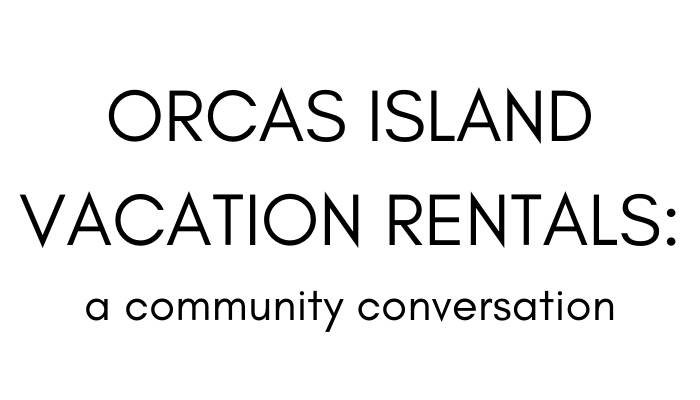The community conversation surrounding vacation rentals continues. The second meeting, held by the Vacation Rental Work Group in the school cafeteria on Wednesday, Sept. 25, concluded the community seeks more support of housing for year-round residents and favored owner-occupied vacation rentals over non-owner occupied vacation rentals.
The conversation focused on answering public questions and goal-setting in an effort to encourage San Juan County to balance restrictions on growth and commercialization of the islands.
According to Washington state’s Growth Management Projections, in the last 40 years, San Juan County’s population quadrupled, growing from approximately 4,000 in 1970 to approximately 16,000 in 2010. In drafting and maintaining its Comprehensive Plan, which establishes a set of long-term goals, policies and land use patterns for the growth of a community, San Juan County is legally bound to comply with growth management rulings. Forecasts in the most recent County Housing Needs Assessment from 2015 indicate between eight and 11 percent of the housing stock may be used for vacation rentals by the year 2036. However, Orcas Island is already at 15 percent, illuminating out of date statistics.Washington’s Growth Management Act does not require a county to consider the impact of visitors.
Currently there is no limit on the number of vacation rentals in the county. Permits pass to new owners with the sale of a property.
On behalf of San Juan County, Community Development Executive Director Erika Shook shared new VR permitting requirements the County Council has appended since 2018. Every existing permit holder now has to apply for renewal annually. This requires acknowledgment and certification of compliance with any new or updated requirements. Legal due process principles require the County to first notify non-compliant permit holders and allow them to respond before termination. County Council has authorized a Code Enforcement Officer, James Finn, to monitor VR rentals.
There are discrepancies and incongruencies with county databases that do not accurately take into account these new regulations, which, according to VR Workgroup Member Joe Symons, “makes the process of public inquiry and understanding more complicated.”
Addressing meeting attendees, Shook said, “This year we gave out $100,000 in [VR permitting] fines. These fees go back into the General Fund, which pays for permit enforcement and salaries. The Community Development team has this on the agenda as part of the Comprehensive Plan update. We will look at saturation of VRs and look at how other communities have addressed that issue. The work you’re doing here will feed nicely into that process.”
In May 2019, the Eastsound Planning Review Committee submitted a proposal to San Juan County for a year-long moratorium on vacation rental permits. It was not approved and a series of community conversations were established by Orcas residents. At the Sept. 25 community meeting, participants were asked to vote on 18 total goals and regulations for SJC. The largest number of votes was for “placing a moratorium on new vacation rental permits until new regulations are adopted.”
An April 2019 study by Harvard Business Review states that the swelling in home-sharing contributes to about one-fifth of the annual increase in U.S. rents and about one-seventh of the average annual increases in U.S. housing prices.
Lynnette Wood, an Orcas resident with a Ph.D. in applied mathematics, illuminated potential impacts of San Juan VRs on year-round housing, showing that the number of VRs are growing relative to the housing stock, with highest VR density on Orcas Island. According to SJC data, out of 1,038 approved VR permitted properties, 12 percent have a 2018-2019 assessed value of $300,000 or less.
“There’s more than one way to define affordable. If you consider $400,000 to be affordable, 27% of approved VR permitted properties are affordable houses. We’re in a highly constrained, highly stressed housing market. There’s no way to tell, however, if VRs would become long term rentals,” Wood said. “…what we do know is one out of 6.5 single-family residences on Orcas are permitted as vacation rentals.”
Comparatively, one out of 11 single-family homes on Lopez is permitted as a vacation rental, and one out of eight on San Juan Island, excluding Friday Harbor which does not allow for VRs.
Paul Kamin, General Manager of Eastsound Water Users Association, presented an Eastsound water use study that supported Wood’s claims. Eastsound is the largest zone served by one water system in the county. Kamin’s data found active vacation rental properties used 45 percent more water per year than a single-family home and 89 percent more water during July and August.
At the end of the meeting, community members voted on potential goals and solutions for regulation. The next community conversation on vacation rentals is slated for Wednesday, Oct. 23 in the Orcas School cafeteria.
“It seems like we need to have a thoughtful discussion about how many [vacation rentals] are enough, how many are too many? The data shows that there is a problem, now it’s time to focus on solutions,” Wood said. Quoting a Chinese proverb, she added, “If we don’t change our direction we’re likely to end up where we’re headed.”




